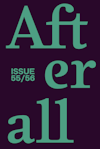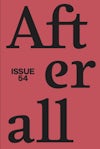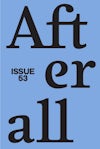
Issue 39
Summer 2015
Issue 39 looks at noise and confusion in the work of Lawrence Abu Hamdan, Jill Magid, Postcommodity and the Center for Historical Reenactments. Peter Pál Pelbart reflects on contemporaneity, while accompanying essays offer detailed studies of Iniva in London and the Museum of Contemporary Art in Sydney.
Editors: Zachary Cahill, Melissa Gronlund, Anders Kreuger, Helena Vilalta, David Morris, Louise O’Hare.
Founding editors: Charles Esche, Mark Lewis.
Table of contents
Foreword
Contextual Essays
- What Is the Contemporary? – Peter Pál Pelbart
- Iniva: Everything Crash – Eddie Chambers
Artists
Postcommodity
- Postmodern Ambush – Lucy R. Lippard
- Reimagining Ceremonies: A Conversation with Postcommodity – Bill Kelley, Jr
Jill Magid
- Jill Magid: A Preamble to a Postscript – Mihnea Mircan
Lawrence Abu Hamdan
- Lawrence Abu Hamdan’s Trilogy of Truth – Anders Kreuger
- Equivocally Yours: A Conversation with Lawrence Abu Hamdan – Robert Leckie
Center for Historical ?Reenactments
- Center for Historical Reenactments: Is The Tale Chasing Its Own Tail? – Khwezi Gule
Events, Works, Exhibitions
- Rethinking ‘Headlands’ – Christina Barton
Foreword
Written by David Morris
What can’t be said, can’t be said, and it can’t be whistled either.
— Fred Moten, ‘frank ramsay / nancy wilson’
This issue of Afterall is noisy, or at least, full of sounds. From 1960s Jamaican vocal groups to harsh noise in indigenous Albuquerque, and from the jokes of gallery guards to the erased words of secret agents, these pages bear sonic artefacts from unexpected places. For the editors, this also comes as something of a surprise: sound was never discussed as the issue came together, nor does this coalesce into anything as coherent as a theme. In many cases, these elements appear outside the main focus of the essays here, in the footnotes and margins, or as artists’ backstories and prehistories.
But these ‘minor’ details are a good place to start. The issue opens with Peter Pál Pelbart’s call for ‘becoming-minor’ in every possible way: reflecting on Immanuel Kant’s understanding of the Enlightenment — which states that to be modern is to reach majority, to ‘grow up’ — Pelbart suggests to be contemporary is to develop minor ways of existing that circumvent and undermine majoritarian, Kantian demands. A similar concern runs through this issue, at different scales: whether the minute plosives of speech or the larger ways in which culture is organised and instituted — and how it may be organised and instituted differently, or perhaps not at all.
Discussing his own musical background with Robert Leckie, Lawrence Abu Hamdan remarks how ‘un-punk’ the world of contemporary art is: as ‘un-punk’ as the mainstream commercial circuits that DIY cultural scenes have long managed to sidestep. This, too, depends on whose ‘punk’ we are talking about. As punk and scholar of Iranian intellectual history Golnar Nikpour has observed, ‘my punk … emerges like an explosion at a particular historical moment in a number of places and then lives many lives enmeshed in colonial and neocolonial power structures and capitalist economies’. Such histories are extremely particular to their contexts, and needn’t offer any general, ‘major’ rules — they also live many lives.
Two of the essays look back to the early days of two very different art institutions, unfolding more or less simultaneously on opposite sides of the globe. Eddie Chambers (whose essay takes its title from The Ethiopians’ 1968 hit ‘Everything Crash’, which has also soundtracked the writing of this foreword) locates the current crisis at London’s Institute of International Visual Arts (Iniva) precisely in its increasing convergence with the procedures of its larger, mainstream competitors — in stark contrast to the self-organised Black activism and artistic activity (of which Chambers was part) that led to its founding. In contrast, Christina Barton describes the inaugural moments of the Museum of Contemporary Art in Sydney, foregrounding indigenous artists’ works from nearby territories in defiance of an increasingly globalised art circuit. In a more speculative way, artist Jill Magid’s amorous provocations of institutional bureaucracy, as catalogued here by Mihnea Mircan, suggest a deeper, stranger dysfunction — malfunctions of desire at the heart of institutional crises.
Purchase
The publication is available for purchase. If you would like specific articles only, it is also available individually and to be downloaded as PDFs.
Purchase full publication
Buy via University of Chicago Press
Buy via Central Books
Purchase individual articles
Buy via University of Chicago Press




